Other Historic Sites in Haddam
Shad Museum
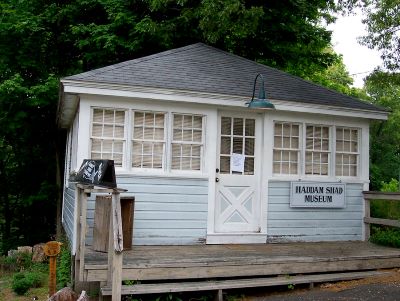 Located at 212 Saybrook Road (Route 154) this small museum is located in the former Maynard's Shad Shack. Shad, the Connecticut State Fish, has been harvested in town since it's founding in 1662 and from 1760 through the 19th century was a successful commercial enterprise. Shad fishing in Haddam was said to "be an industry of much profit and importance." In 1814 there were at least 17 locations in town where shad were caught and that year saw a catch of 200, 000. Over most of the history or shad fishing, it was done by 'haul seining' during the daytime but this practice stopped in the 1950's when the fish became less numerous and the river travel increased. Shad fishing now is done by law at night with 'drift nets.' Boning shad was and is today considered an art form.
Located at 212 Saybrook Road (Route 154) this small museum is located in the former Maynard's Shad Shack. Shad, the Connecticut State Fish, has been harvested in town since it's founding in 1662 and from 1760 through the 19th century was a successful commercial enterprise. Shad fishing in Haddam was said to "be an industry of much profit and importance." In 1814 there were at least 17 locations in town where shad were caught and that year saw a catch of 200, 000. Over most of the history or shad fishing, it was done by 'haul seining' during the daytime but this practice stopped in the 1950's when the fish became less numerous and the river travel increased. Shad fishing now is done by law at night with 'drift nets.' Boning shad was and is today considered an art form.
Veteran's Museum
This site dedicated to the men and women who served our country in the Armed Forces is located in the old Firehouse station on the southern side of the Higganum Green on Candlewood Hill Road.
Higganum Feed Store
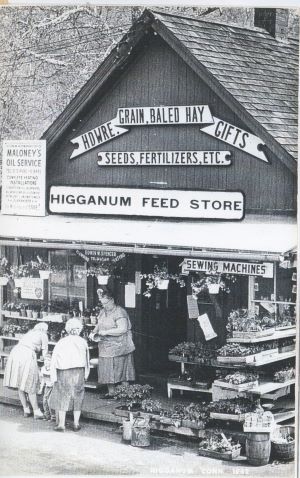 This wonderfully preserved commercial establishment was erected around 1880 during the heyday of Higganum's industrial activity and has for over 120 years provided local citizens with agricultural goods. Buckley E. Johnson was responsible for constructing the Feed Store and it remained in the family until 1924. The feed store is now known as the Red Barn Hardware.
This wonderfully preserved commercial establishment was erected around 1880 during the heyday of Higganum's industrial activity and has for over 120 years provided local citizens with agricultural goods. Buckley E. Johnson was responsible for constructing the Feed Store and it remained in the family until 1924. The feed store is now known as the Red Barn Hardware.
Higganum Grange
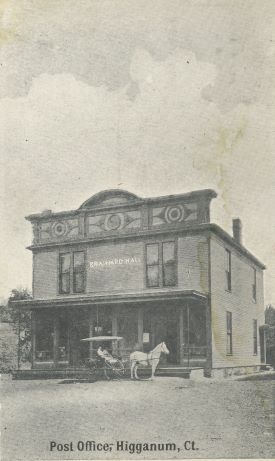 It is said that the Bank Building Company erected this commercial structure with decorative parapet (or false front) in 1882 which originally housed Emmett Spencer's grocery store, the post office and bank. The upstairs was used to show movies with a piano accompanist and also used as a basketball court. For some time the building was known as Brainard Hall. The Haddam Grange was organized in 1891 and had rented space above Olsen's Store for 45 years (located directly to the north of the existing grange and no longer standing). In 1896 the Grange changed its name to Higganum Grange and in 1936 purchased it as their headquarters. The ground floor has been converted to a grocery store.
It is said that the Bank Building Company erected this commercial structure with decorative parapet (or false front) in 1882 which originally housed Emmett Spencer's grocery store, the post office and bank. The upstairs was used to show movies with a piano accompanist and also used as a basketball court. For some time the building was known as Brainard Hall. The Haddam Grange was organized in 1891 and had rented space above Olsen's Store for 45 years (located directly to the north of the existing grange and no longer standing). In 1896 the Grange changed its name to Higganum Grange and in 1936 purchased it as their headquarters. The ground floor has been converted to a grocery store.
Brainerd Memorial Library
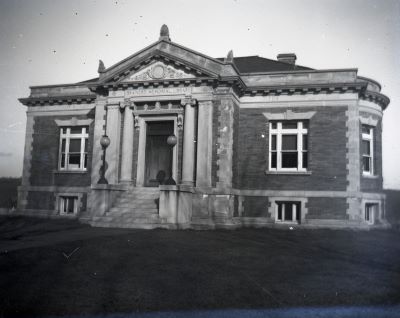 One of Haddam's finest structures, the Brainerd Memorial Library is located along the east side of Saybrook Road on land donated by Judge Ephraim P. Arnold. The Library was built between 1906-1908 with a generous donation from Cyprian Strong Brainerd, a New York City lawyer and Haddam Neck native. The Boston architectural firm of McLean and Wright designed the original Beaux-Arts style brick building. The façade features central entrance pavilion with a pedimented gable supported by Doric columns and pilaster. The interior lobby features an ornate dome with the Brainerd coat of arms and figures symbolic of Commerce, Justice, Art, and Music. In 1996 a large addition was erected to the rear and features matching brick and architectural details.
One of Haddam's finest structures, the Brainerd Memorial Library is located along the east side of Saybrook Road on land donated by Judge Ephraim P. Arnold. The Library was built between 1906-1908 with a generous donation from Cyprian Strong Brainerd, a New York City lawyer and Haddam Neck native. The Boston architectural firm of McLean and Wright designed the original Beaux-Arts style brick building. The façade features central entrance pavilion with a pedimented gable supported by Doric columns and pilaster. The interior lobby features an ornate dome with the Brainerd coat of arms and figures symbolic of Commerce, Justice, Art, and Music. In 1996 a large addition was erected to the rear and features matching brick and architectural details.
The founders of the library "set out to establish and maintain a public library and reading room and rooms for the purpose of science and art." The Haddam Library Association, which was founded in 1896 donated many of the original books. The town had several previous "Library Associations" dating back to the late 1700's including the Wide Awake Society and Haddam Anti-Slavery Society. Today the library is operated by a Board of Directors and has an active Friends of the Library association.
Mill Creek - Connecticut Valley Railroad Bridge
Mill Creek received its name from a grist mill built along the stream in 1706. The railroad bridge, which dates from about 1870, allowed the Connecticut Valley Railroad to traverse the creek. Haddam had 5 railroad stations Higganum, Walkley, Haddam, Arnolds, Goodspeed (Tylerville). The bridge's big claim to fame is that it appeared in the 1958 Doris Day movie It Happened to Jane.
Spencer's Shad Shack
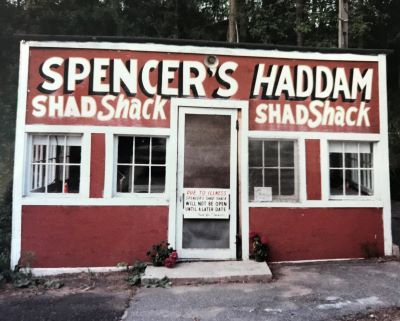 A local landmark since 1930, Spencer's Shad Shack located along the east side of Route 154 south of the UCONN Extension Center. Shad have played an important role in the community's history and Spencer's is one of the few tangible links to our robust shad fishing heritage.
A local landmark since 1930, Spencer's Shad Shack located along the east side of Route 154 south of the UCONN Extension Center. Shad have played an important role in the community's history and Spencer's is one of the few tangible links to our robust shad fishing heritage.
Camp Bethel
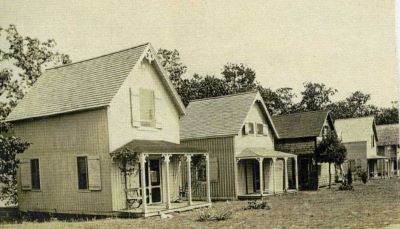 Located on the east side of Camp Bethel Road, the Camp Bethel Campground sits on a campus of 55 acres extending to a bluff overlooking the Connecticut River. In 1878 the property was leased to Jared S. Clark for "camp meeting purposes, July-September." In 1887 the Life and Advent Campmeeting Association was established and purchased the land for a permanent campground. Early campmeetings were held the first two weeks of August and attended by people from all over the country. Tents were placed around a central chapel. Over time the tents were replaced with cottages and the camp became a full summer retreat. In 1965 the organization became nondenominational and was renamed the Camp Bethel Association.
Located on the east side of Camp Bethel Road, the Camp Bethel Campground sits on a campus of 55 acres extending to a bluff overlooking the Connecticut River. In 1878 the property was leased to Jared S. Clark for "camp meeting purposes, July-September." In 1887 the Life and Advent Campmeeting Association was established and purchased the land for a permanent campground. Early campmeetings were held the first two weeks of August and attended by people from all over the country. Tents were placed around a central chapel. Over time the tents were replaced with cottages and the camp became a full summer retreat. In 1965 the organization became nondenominational and was renamed the Camp Bethel Association.
Early tents were white and embellished with red braid trim. These were replaced with Victorian-style cottages similar to those found on Martha's Vineyard and could feature board and batten siding, bargeboarding and decorative trim. Most cottages were built between 1890-1920, although later ones continue to feature decorative details. The Boyd Memorial Chapel in the center of the grounds is three stories with a two-tiered porch and ornate trim.
Connecticut Yankee Atomic Power Plant
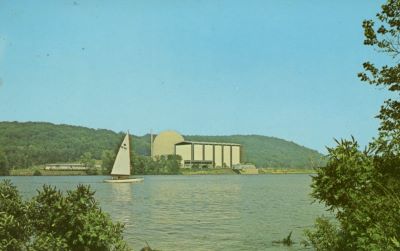 Construction started on Connecticut's first commercial nuclear power plant in 1964 on the site of William Bradway's small commercial airport along the east bank of the Connecticut River. The property was formerly the farm of Hezekiah Brainerd. Connecticut Yankee was the second nuclear power plant in New England and the sixth in the entire nation. It began commercial operation in 1968 and over the next 28 years produced 110 billion kilowatt hours of electricity. In 1996 the plant was closed and all of the infrastructure has been removed with the exception of the dry cask storage of the spent nuclear fuel.
Construction started on Connecticut's first commercial nuclear power plant in 1964 on the site of William Bradway's small commercial airport along the east bank of the Connecticut River. The property was formerly the farm of Hezekiah Brainerd. Connecticut Yankee was the second nuclear power plant in New England and the sixth in the entire nation. It began commercial operation in 1968 and over the next 28 years produced 110 billion kilowatt hours of electricity. In 1996 the plant was closed and all of the infrastructure has been removed with the exception of the dry cask storage of the spent nuclear fuel.
Haddam Neck Grange Hall and Fairgrounds
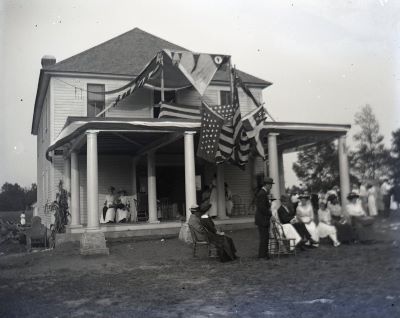 This Colonial Revival style grange hall was erected in 1911 (1914 LB) by the Haddam Neck Grange No. 177 P. of H. to serve as a meeting hall and main building for the Haddam Neck Fair. The Grange was organized in 1910 and for many years promoted local agriculture and road improvements. The Grange was disbanded in 1966. An affiliated organization, the Haddam Neck Grange Agricultural Association was formed in 1911 and was responsible for the operation and financial success of the Haddam Neck Fair. The fair, which is always held on Labor Day weekend has grown from a small local one day event to one of Connecticut's major agricultural state fairs. The fair is steeped in tradition and residents can still exhibit their fruits, vegetables, cattle, poultry, fancy work and baked goods. As the fair grew the Association purchased adjoining land and erected additional buildings including barns, offices and display buildings. Today, the Haddam Neck Fair is a 4-day event and one of the community's most anticipated affairs.
This Colonial Revival style grange hall was erected in 1911 (1914 LB) by the Haddam Neck Grange No. 177 P. of H. to serve as a meeting hall and main building for the Haddam Neck Fair. The Grange was organized in 1910 and for many years promoted local agriculture and road improvements. The Grange was disbanded in 1966. An affiliated organization, the Haddam Neck Grange Agricultural Association was formed in 1911 and was responsible for the operation and financial success of the Haddam Neck Fair. The fair, which is always held on Labor Day weekend has grown from a small local one day event to one of Connecticut's major agricultural state fairs. The fair is steeped in tradition and residents can still exhibit their fruits, vegetables, cattle, poultry, fancy work and baked goods. As the fair grew the Association purchased adjoining land and erected additional buildings including barns, offices and display buildings. Today, the Haddam Neck Fair is a 4-day event and one of the community's most anticipated affairs.
